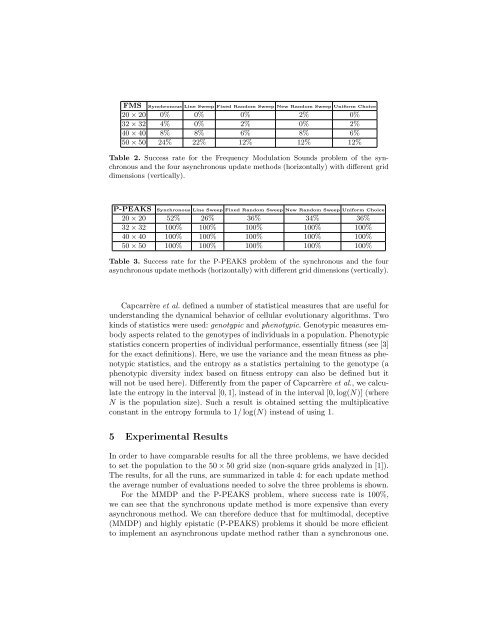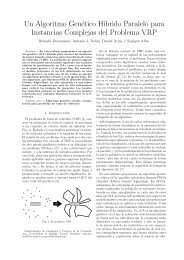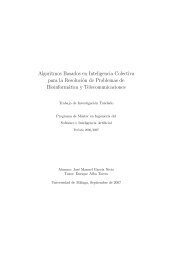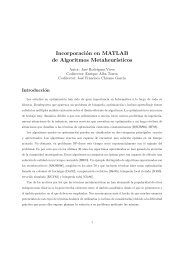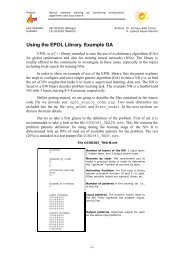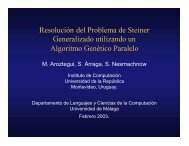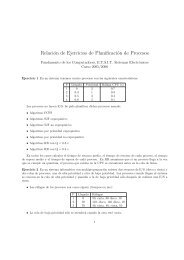Comparing Synchronous and Asynchronous Cellular Genetic ... - NEO
Comparing Synchronous and Asynchronous Cellular Genetic ... - NEO
Comparing Synchronous and Asynchronous Cellular Genetic ... - NEO
Create successful ePaper yourself
Turn your PDF publications into a flip-book with our unique Google optimized e-Paper software.
FMS <strong>Synchronous</strong> Line Sweep Fixed R<strong>and</strong>om Sweep New R<strong>and</strong>om Sweep Uniform Choice<br />
20 × 20 0% 0% 0% 2% 0%<br />
32 × 32 4% 0% 2% 0% 2%<br />
40 × 40 8% 8% 6% 8% 6%<br />
50 × 50 24% 22% 12% 12% 12%<br />
Table 2. Success rate for the Frequency Modulation Sounds problem of the synchronous<br />
<strong>and</strong> the four asynchronous update methods (horizontally) with different grid<br />
dimensions (vertically).<br />
P-PEAKS <strong>Synchronous</strong> Line Sweep Fixed R<strong>and</strong>om Sweep New R<strong>and</strong>om Sweep Uniform Choice<br />
20 × 20 52% 26% 36% 34% 36%<br />
32 × 32 100% 100% 100% 100% 100%<br />
40 × 40 100% 100% 100% 100% 100%<br />
50 × 50 100% 100% 100% 100% 100%<br />
Table 3. Success rate for the P-PEAKS problem of the synchronous <strong>and</strong> the four<br />
asynchronous update methods (horizontally) with different grid dimensions (vertically).<br />
Capcarrère et al. defined a number of statistical measures that are useful for<br />
underst<strong>and</strong>ing the dynamical behavior of cellular evolutionary algorithms. Two<br />
kinds of statistics were used: genotypic <strong>and</strong> phenotypic. Genotypic measures embody<br />
aspects related to the genotypes of individuals in a population. Phenotypic<br />
statistics concern properties of individual performance, essentially fitness (see [3]<br />
for the exact definitions). Here, we use the variance <strong>and</strong> the mean fitness as phenotypic<br />
statistics, <strong>and</strong> the entropy as a statistics pertaining to the genotype (a<br />
phenotypic diversity index based on fitness entropy can also be defined but it<br />
will not be used here). Differently from the paper of Capcarrère et al., we calculate<br />
the entropy in the interval [0, 1], instead of in the interval [0, log(N)] (where<br />
N is the population size). Such a result is obtained setting the multiplicative<br />
constant in the entropy formula to 1/ log(N) instead of using 1.<br />
5 Experimental Results<br />
In order to have comparable results for all the three problems, we have decided<br />
to set the population to the 50 × 50 grid size (non-square grids analyzed in [1]).<br />
The results, for all the runs, are summarized in table 4: for each update method<br />
the average number of evaluations needed to solve the three problems is shown.<br />
For the MMDP <strong>and</strong> the P-PEAKS problem, where success rate is 100%,<br />
we can see that the synchronous update method is more expensive than every<br />
asynchronous method. We can therefore deduce that for multimodal, deceptive<br />
(MMDP) <strong>and</strong> highly epistatic (P-PEAKS) problems it should be more efficient<br />
to implement an asynchronous update method rather than a synchronous one.


